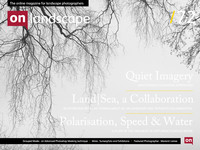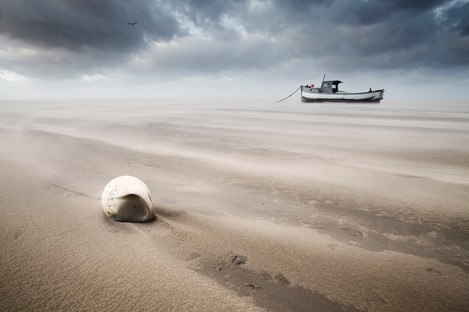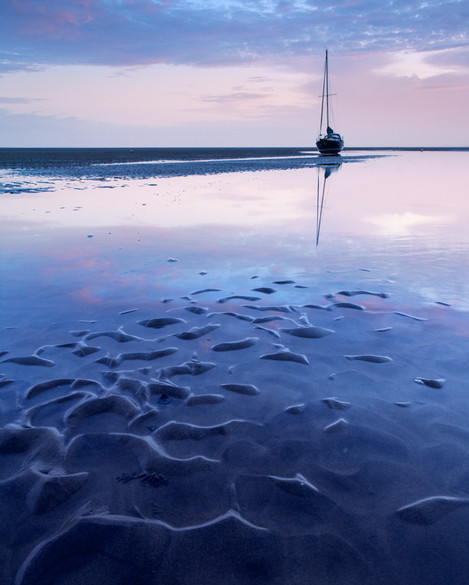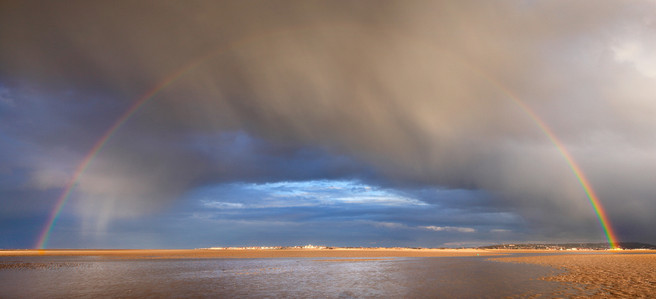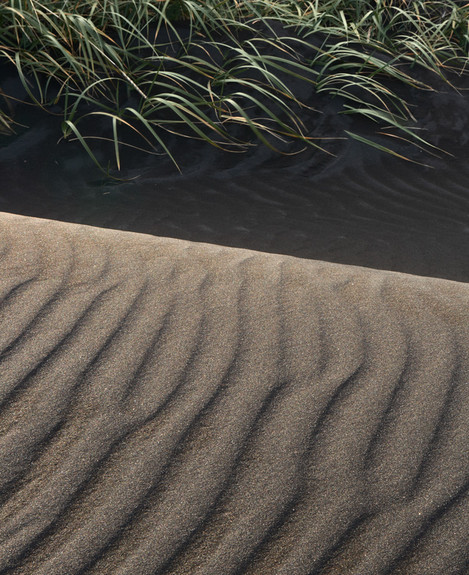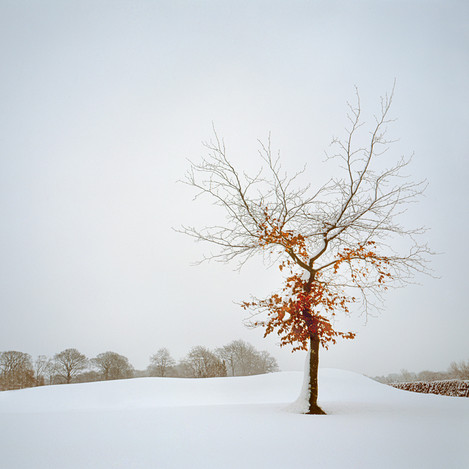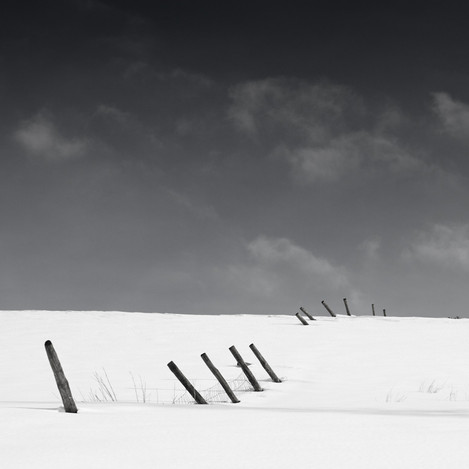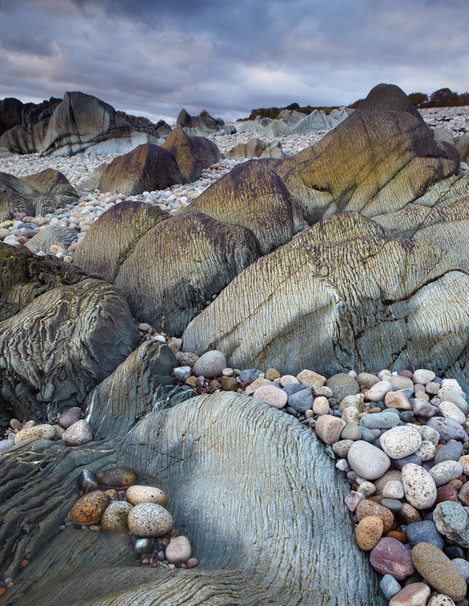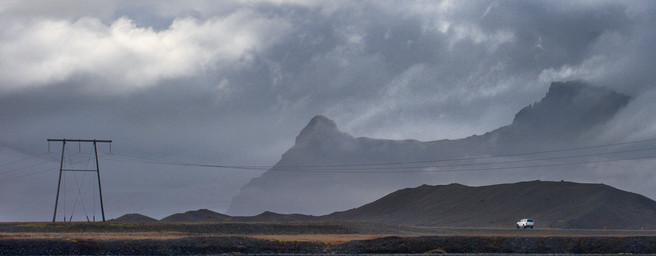Featured Photographer

Marianthi Lainas
A professional photographer based in Hoylake on the Wirral peninsula.

Michéla Griffith
In 2012 I paused by my local river and everything changed. I’ve moved away from what many expect photographs to be: my images deconstruct the literal and reimagine the subjective, reflecting the curiosity that water has inspired in my practice. Water has been my conduit: it has sharpened my vision, given me permission to experiment and continues to introduce me to new ways of seeing.
While UK’s coastline draws photographers from far and wide, the chances are that The Wirral may not be uppermost in your mind when contemplating your next excursion. It is home to Marianthi Lainas, whose deceptively simple and often peaceful images suggest that we may be overlooking something in our search for high drama.
Certainly they are a good reminder that photography does not have to involve lots of travel. I have come to know Marianthi through the Landscapes by Women community, but it’s possible that you may previously have seen her work in “Practical Photography” and “Digital Photo” magazines – her image “Abandoned Boat” was selected as overall winner of their 2012 “Photographer of the Year” competition.
Can you tell me a little about your education, childhood passions, early exposure to photography and vocation?
As I child I loved art and up until the age of eleven or twelve I always seemed to be drawing or painting something. I went to a very academic secondary school, where art wasn't really encouraged and so ended up studying more traditional subjects. My interest in, and appreciation of visual art fell very much by the wayside, as studying and then work took over. I'm very much a latecomer to photography, having only really 'caught the bug' six years ago.
Growing up I only had a pocket camera and photography was just a way of recording snapshots of holidays or social occasions. Without any early exposure to photography via family or friends, it just never occurred to me that a camera could be used creatively.
What are you most proud of in your photography?
If someone had told me ten years ago that I would be not only passionate about photography but that I would also be making some income from something I love, I would never have believed them. Proud may not be the right word, but I do feel incredibly fortunate to be doing something I love and it does feel special when somebody is prepared to spend money on one of my prints.
In most photographers lives there are 'epiphanic’ moments where things become clear, or new directions are formed. What were your two main moments and how did they change your photography?
The first significant moment was probably when I started to realise that I didn't need to travel to lots of well-known photographic locations in order to develop as a photographer. Working part-time at that point, finances were somewhat stretched and I just couldn't justify the fuel costs involved in travelling to lots of different parts of the country. I live in a lovely place to which I have a strong emotional attachment and I've found there are endless photographic opportunities to explore right here on my doorstep. That doesn't mean I have lost the desire to travel and experience new landscapes, far from it, it's just that I'm more content to explore locally these days.
The second came a few years after I started taking photographs and was becoming unhappy with my images, not realising quite why they weren't working for me. I would start processing an image and just not be satisfied although I felt that there was something in there somewhere! I started to really experiment with cropping images, sometimes very dramatically, and discovered that the resulting images worked much better. It’s something I initially was only able to see once that rectangular image was on my computer back at home, having completely missed it whilst out on location, surrounded by lots of other visual distractions. The cropping was sometimes so dramatic as to make the edited image unusable but the process itself really helped to train my eye.
Tell me about why you love landscape photography? A little background on what your first passions were, what you studied and what job you ended up doing.
Like the majority of landscape photographers I love being outdoors. I grew up on the Wirral peninsula and remember spending a lot of time outside , playing on the beach and making dens. My father was a teacher and for six weeks each summer we would head off in our old split-screen VW camper van for camping holidays in North Wales or the Lake District.
Being out in the landscape fills me with a sense of freedom. It's when I'm out with my camera that I feel most alive and at the same time the most at peace. I find landscape photography completely absorbing, a total distraction from daily worries.
I studied languages at university, lived in France for a year and ended up working as a systems analyst for a large multinational company throughout my twenties. I did a lot of travelling around Europe before realising that long-term the job was not for me. I ended up having a complete change of career direction, moved back up to the Wirral and spent the next decade and a half working in community and voluntary sector development which I loved.
At various points over the years, usually when I felt my work-life balance was out of sync, I had tried to rekindle my early love of art by dabbling with painting, both in watercolours and oils. But I never felt either of these mediums were for me and it wasn't until around 2008 that I had a real 'eureka' moment and realised that photography could be a creative art form.
After taking voluntary redundancy from my job, I experienced a short illness and really needed some kind of creative sabbatical. My brother was about to upgrade his digital camera and gave me his old Olympus bridge camera to use. Within a few weeks I was completely hooked and realised that I had finally found the perfect creative outlet for me!
Could you tell us a little about the cameras and lenses you typically take on a trip and how they affect your photography?
I use predominantly digital equipment. I have a Canon 5D MKii and a variety of Canon lenses although I now find that I rarely use anything other than the 24-70mm f2.8 and the 70-200mm f4 lenses. I went through a phase of using the 17-40mm but now find it too wide for my taste. I also have a set of Lee filters which I use all the time.
My back has recently started to complain a bit about the weight of my camera bag and so if I am out photographing locally I will usually just take out one lens, which I find has also helped my photography. Rather than switching lenses all the time, all my attention is on the subject and the framing. A year ago I bought a medium format Mamiya 7ii film camera with 50mm lens. On the occasions I have used it I have loved some of the resulting images. It's a whole lot lighter to carry than the digital equipment and really forces me to think very carefully before I take a shot.
However, I'm not sure I've got to grips with scanning transparencies properly yet (I use anEpson v700) which can frustrate me. Also because I use my digital equipment for all my commercial work, I find that I still automatically reach for the Canon when going out.
What sort of post processing do you undertake on your pictures? Give me an idea of your workflow.
I use Capture One for RAW processing where I'll make some basic adjustments like straightening, exposure tweaks, white balance and some colour corrections. Deciding if any adjustments are needed to the white balance settings is a critical part of my workflow as it can completely alter the whole mood of the image and what I am trying to convey. I'll then export as a 16-bit tiff file to Photoshop for further processing, which is usually a series of curves adjustment layers with some possible further colour correction. Sometimes I'll work in Lab mode to make adjustments and then switch back to RGB mode to make further changes.I'll end up with several versions of a particular file:
1) A 16 bit tiff file with all my adjustments so I can go back and change if needed.
2) For images that will go on to be printed, I'll save additional 'print ready' versions to which I will have made further adjustments during the soft-proofing process.
Do you get many of your pictures printed and, if at all, where/how do you get them printed?
I print quite a few of my images as I exhibit/sell at art fairs and other events throughout the year. For me, printing is the final stage in the creative process and I get a great deal of satisfaction from seeing one of my images that has worked well in print.
Initially I used a professional print lab but realised fairly early on that I preferred to have complete control over the printing process. So I now produce all prints myself. As a result, I have discovered that printing is a whole art form in itself! Neil Barstow from colourmanagement.net was a great source of information, helping me to get started on the process and I now feel that I've got a reasonable understanding of colour profiling and colour management.
For a while I used an Epson R2400 A3+ printer but la st year inherited an old Epson 4000 17" machine from a friend who is a fine art printer here on the Wirral. For the moment, it still works brilliantly, I'm really happy with the prints it is producing and also that my overall ink costs are now much lower.
As well as prints I also produce greetings cards and calendars which I supply in reasonably high volume to local retailers. For these commercial products, it's much more practical and cost effective to use an external print house and I use Advantage Digital Print in Dorchester to produce these for me.
Tell me about the photographers that inspire you most. What books stimulated your interest in photography and who drove you forward, directly or indirectly, as you developed?
The photographers whose work first had an impact on me were Bill Brandt and not unsurprisingly, Ansel Adams. Michael Kenna is another inspiration. I recently visited his retrospective at The Brindley Arts Centre in Warrington and was able to hear him talk about the philosophy behind his work. His prints in the flesh are exquisite.
Seeing David Ward's work for the first time really inspired me to start looking at the world in a different way and I find his writing particularly insightful. Bruce Percy is also a real favourite - I find his work very emotive and beautiful and love his approach to photography. Although my photographic book collection is small, I also own a couple of his monographs. I find that I am also increasingly inspired by artists who are not photographers. There's a vibrant network of artists across the Merseyside area, I go to a lot of art exhibitions and also help to organise the annual Wirral Open Studio Tour. Being part of this group for the past couple of years has, indirectly and quite unexpectedly, really helped my photography to progress. I've learnt so much about light, colour and composition from artists working in other media.
Tell me what your favourite two or three photographs are and a little bit about them.
My favourites change a lot as I tend to go off my images fairly quickly! If an image makes it onto my wall at home, then it becomes a favourite for a while and usually these will also have a special personal memory attached to them.
1. Stokksnes Dunes
The memories of my trip to Iceland last September are still fresh in my mind and this abstract image of the black dunes and grass detail at Stokksnes b each is currently a favourite from that portfolio. I spent an hour or so here while my partner was playing golf nearby (amazing how he is always able to find a golf course, wherever we are in the world!). There are dramatic views of Vestrahorn mountain from the beach and although I made a few images of the wider view, I got a much greater sense of creative satisfaction from this more abstract view.
2. Winter Tree
This image of a little tree in the snow was the first photograph I took using my Mamiya film camera. Having never used a film camera properly before, I was pleased I had at least exposed the film correctly! Although the subject matter of 'lone tree in snow' is not exactly original, when printed there is some very subtle and beautiful, bluish toning from the film that I just love. I had taken my digital camera out with me and took the same shot with my Canon 5D MKii but was unable to achieve the same subtle toning through post-processing.
3. Posts in Snow
Another image from a snowy day which was made out in North Wales last March. It was the end of a long day spent wading through deep snow drifts. Living on a low-lying peninsula, we don't get to see much snow and so the prospect of being able to photograph the landscape in these conditions is always hugely exciting. I remember feeling exhausted walking up a steep hillside in thick snow in search of a composition that really appealed to me, and then experiencing that wonderful flood of energy that you get when you finally look through the viewfinder and love how all the elements of your image have come together.
If you were told you couldn’t do anything photography related for a week, what would you end up doing (i.e. Do you have a hobby other than photography.)
I love being out in the landscape. Before I developed an interest in photography I would spend most weekends walking with friends. So I guess I'd spend a lot of time walking on our local beaches or getting out into the hills of North Wales.
For any longer period of time, however, I'd need to find another creative outlet. I have no idea what that might be, but I'd probably end up enrolling on an art workshop or two to try something different.
What sorts of things do you think might challenge you in the future or do you have any photographs or styles that you want to investigate? Where do you see your photography going in terms of subject and style?
At the moment I am making a reasonable income from photography but this comes from many varied sources and I would say that it is certainly a challenge to keep finding and sustaining new sources of revenue. Although I do a certain amount of business planning, there’s no overall grand plan. I think I have definitely reached the age (half century milestone looming this year!) where I am much more philosophical about my working life, and as a result I’m kind of open to where my photographic journey may take me. Obviously bills need to be paid, but if there comes a point when I find that the joy is disappearing from making photographs, then I’ll have no hesitation in finding another way of making an income and go back to photography as purely an outlet for personal creativity.
Excitingly, I have just been offered space for a solo exhibition of my Icelandic images at Liverpool’s Nordic Church which will take place between 5th-24th September this year as part of the Liverpool Independents Biennial International Arts Festival. It’s a venue that often hosts art exhibitions with a Nordic theme. It’s a beautiful building with some interesting spaces and so I’m really looking forward to the challenge of preparing for this. I’ll also be running a few more workshops in the North West and further afield this year with my colleague, Eli Pascall-Willis.
My personal work is definitely becoming more abstract in style and it would be good to work on creating a cohesive series of work. I've learned, particularly in the last year, that I really need to set aside time for personal projects and that developing new ideas, allowing myself thinking space and working creatively really does take quite a bit of time. So, that's part of the plan for this year - more hours in the day please!
Much of your work is close to your home. How important is a sense of place and a connection with the land to you?
I grew up in this area of the country and moved away for 15 years to study and work before then returning. The Wirral peninsula is a relatively small area of around 60 square miles but the majority of my images are made within an even smaller area, probably just a few miles from my home at the tip of the peninsula. I can't imagine living anywhere else and I have that very strong emotional attachment which comes from living in a place for a long period of time . As a result, I think my local work generally holds much greater meaning for me. I live a stone's throw from the sea, am lucky enough to see the beach from my house and I spend a lot time walking out on the open sands of the Dee Estuary. Getting to know an area really well also has some obvious advantages from a photographic point of view - I feel very in tune with tides, and understand weather patterns and differences in light depending on the time of year.
There is a quietness to your work, and simplicity in your placement of elements which are often sparingly used. Is this a conscious style ?.
It's certainly true that I prefer a minimalist look when it comes to composition and I'm very drawn to simple, strong and graphical forms in the landscape. I don't have any formal training in graphic design but when I worked in the voluntary sector, I often found myself designing leaflets, newsletters and the occasional website for various projects which I always really enjoyed. As my photography has developed I have found that I also prefer a more muted colour palette in my images. I've become much more aware of the subtleties of colours found in nature and how to combine colours to capture the mood of a scene without automatically cranking up the saturation and vibrance sliders. I think all my most recent images don't 'shout out' so much in that respect. A few other people have commented on the quietness of my images - it's not something that I am consciously trying to achieve, but I do feel very at peace when I am out photographing the landscape (regardless of the weather conditions!) so maybe that's what being reflected in my images.
You’ve mentioned that you enjoy talking to potential customers. Does this feed back into your image making?
Well, I do love a good chat, that's for sure! Landscape photography is generally a solitary activity and although I feel very comfortable in my own company and love the freedom of being self-employed, I also really look forward to events where I can meet other artists and talk to visitors.
I find that my more classic landscape images far outsell any of my abstract work and local scenes are consistently popular. So, I suppose that I am mindful of this when I am out making images. However, if people tell me they are looking for a particular view, I can’t say that I then rush out to make images as a result! I did once accept a commission from a customer who wanted a print of a favourite view for a Christmas gift but I admit that I really didn't enjoy the experience.
As I’m trying to make an income from photography, I do need to consider what might sell and for the moment there seems to be a market for my photographic style. As my photography develops, that may or may not continue, but whatever happens, it’s really important to keep getting personal satisfaction from making images as this is what truly motivates me.
Your images from Iceland go beyond the usual floes and aurora. What was your experience of the country and did you gain any new insights from your trip?
I completely fell in love with the Icelandic landscape when we visited last September – it’s no exaggeration to say that it really touched my soul and it is no wonder that it is such a popular place for photographers to visit. We hired a small camper van for our 12 day trip and that really helped to make the experience so much more intense. When we returned a lot of people wanted to know whether we had seen and photographed the aurora! I must admit neither of us had been particularly bothered whether we experienced the northern lights or not - if we had, then of course I would have photographed them, but as more of a documentary record. Although I'm not a fan of bright green skies in an image, my impressions of Iceland were all to do with colour - blacks and golds, blues and whites, I just loved the combination of colours that we saw in the landscape. That colour palette, combined with dramatic shapes and forms really struck a chord with me, the possibilities for image-making were endless and I would love to go back to and explore in more detail. I found that my ability to see not just the ‘wider view’ but to visually isolate more graphic and abstract shapes really developed while I was there and this has helped reinvigorate my photography now that I’m back on home soil.
Who do you think we should feature as our next photographer?
Either Ian Bramham, another North West photographer, whose black and white images I admire very much. Or Glyn Davies, from Anglesey, whose portfolio includes some evocative images of the North Wales/Snowdonia area. Glyn is also one of the handful of UK landscape photographers who runs his own gallery and he produces some fantastic prints which are really worth a look if you are in the area.
Thank you Marianthi for the insights you have provided us with. You can see more of Marianthi’s photography and find details of her forthcoming exhibitions and shows on her website.

